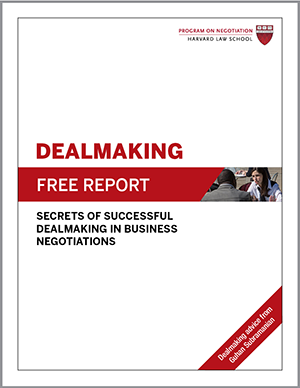
When two sides seem far apart on a contract dispute, careful and creative deal structuring and negotiating can often result in a winning agreement for both sides. Here’s an example of how that might look in a business deal, based on a question we recently received.
“My company, a large multinational, contracts with an outside vendor for some of our software infrastructure. Due to new regulatory requirements, we have asked the vendor’s team to upgrade certain features of the software. We think that we should get these upgrades for free because these enhanced features may be needed by their other clients soon. They are asking us to pay $5 million for the upgrades because they claim they don’t foresee being able to sell the upgrades to other clients.
On one hand, $5 million is way too high; we estimate that time and materials (the criteria we use with them on smaller modifications) would cost them about $3 million. On the other hand, we don’t have any other options: this particular software is highly customized, and switching costs would be prohibitively expensive for us (and they know this). What should we do?”
How to use deal structuring and negotiating to solve contract disputes
Instead of haggling over the price of the software upgrades (which may lead to an impasse on this critical need for your company), there are two deal structuring and negotiating moves you should consider.
First, what if you used a time and materials approach, with a cap at $5 million? If you are correct, then you will get a $3 million bill. In the worst-case scenario, you will pay the vendor’s proposed price of $5 million. Of course, you would need to monitor the project more closely than you would if their fee were simply project-based to ensure that your vendor was not spending time or money unnecessarily. But it sounds like a time and materials approach has worked reasonably well in your smaller upgrade projects, and it would give you a principled approach to avoid debating how much effort this upgrade will actually entail.
Second, consider a contingent contract, which would effectively “bet” on your different expectations regarding the possibility of future clients for this upgrade. Many different deal structuring and negotiating set ups would accomplish this. Here’s one of them: Your vendor develops the upgrade and owns the intellectual property (since presumably the upgrade “works” only with the vendor’s existing software, which they own), but you would have exclusive rights to use the upgrade. If your vendor wishes to sell the upgrade to someone else, they would owe you, say, $500,000 for the first instance and, say, $250,000 for each additional instance. You might further specify that you can veto certain kinds of sales (e.g., to your competitors).
These contingencies should be a very cheap “give” for your vendor, since they have told you that they don’t expect to have any other clients for the upgrade. And notice that if they do complain about the $500K/$250K rebates, you’ve just learned that they don’t think the possibility of future clients is zero.
Some experts recommend contingent contracts as a natural win-win solution when there is a negotiation impasse. Generally, these kinds of contingencies should be a tool of last resort rather than a first resort. Why? Because they can create unnecessary complexity and “kinks” in incentive functions that can create moral hazard problems. But in this situation, a well-structured contingent contract may be needed because you and your counterpart are so far apart on price.
One final detail, related to this last point: In the deal structuring and negotiating over the rebate amounts, you might want to leave some value on the table to maximize the vendor’s incentive to find additional clients. They are in the software business, and you are not, which means that you will have to rely on them to find potential applications for the upgrade. The more of a cut you take out of those additional revenues, the less incentive they will have to find those revenues in the first place.
What experiences have you had with creative deal structuring and negotiating to help solve an impasse?





